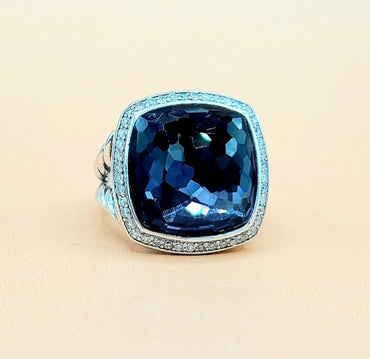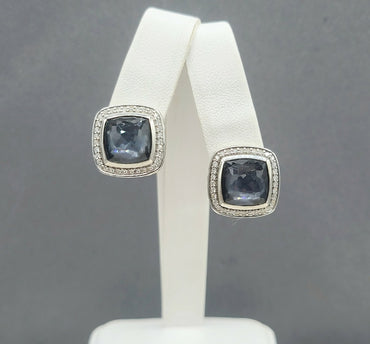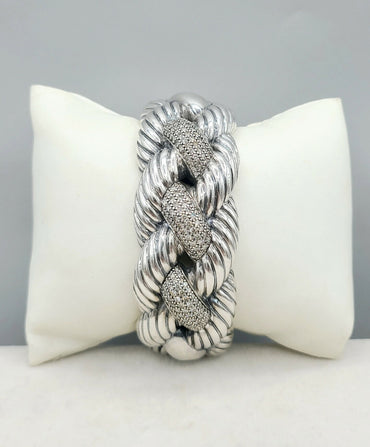
What Goes Where in a Jewelry Box: Complete Organization Guide for AYW Luxury
Key Takeaways
- Organize by type: Separate necklaces, rings, earrings, and bracelets into designated compartments
- Prevent damage: Use soft-lined dividers and secure clasps to avoid scratches and tangles
- Maximize space: Utilize adjustable compartments and vertical storage for efficient organization
- Daily vs. special: Create zones for everyday jewelry versus special occasion pieces
- Maintenance matters: Regular cleaning and proper storage extend jewelry's lifespan
Introduction
Have you ever asked yourself, what goes where in a jewelry box? At AYW Luxury, we understand how important it is to protect and beautifully present your treasured jewelry collection. This guide walks you through the essential parts of a jewelry box and how to organize necklaces, rings, earrings, and bracelets systematically. Whether you're preparing a gift or simplifying daily storage, our tips and tricks will help keep your jewelry untangled, accessible, and safe—all while enhancing your space's elegance.
1. Organizing Your Jewelry with Ease
Creating an organized jewelry collection transforms your daily routine and protects your valuable pieces. Understanding the fundamental principles of jewelry organization ensures that each piece has its designated place, reducing damage and making your morning preparations effortless. The key lies in recognizing that different types of jewelry require specific storage solutions based on their unique characteristics and vulnerability to damage.
When approaching jewelry organization, consider both functionality and aesthetics. A well-organized jewelry box not only protects your pieces but also creates a luxurious experience every time you select an accessory. The visual appeal of a systematically arranged collection adds to the joy of owning beautiful jewelry, making each piece feel special and easily accessible.
2. Step-by-Step Guide to Properly Placing a Necklace in a Jewelry Box
Preparation and Cleaning
Before storing any necklace, always clean and untangle it completely. This initial step prevents long-term damage and ensures your necklaces remain in pristine condition. Use a soft cloth to remove any oils, makeup residue, or environmental buildup that could cause tarnishing or discoloration over time.
Essential preparation steps:
- Gently clean each necklace with appropriate cleaning solutions
- Check for loose stones, weak links, or damaged clasps
- Allow pieces to dry completely before storage
- Inspect for any signs of wear that might need professional attention
Securing Clasps and Preventing Tangles
One of the most crucial aspects of necklace storage is securing the clasp properly. This simple action prevents the devastating tangles that can damage delicate chains and create frustrating knots. Always fasten the clasp completely and ensure the necklace forms a complete circle before storage.
For particularly delicate or valuable pieces, consider using individual protective pouches within your jewelry box. This extra layer of protection prevents metal-on-metal contact that could cause scratches or chain damage. Soft fabric pouches or individual compartments lined with velvet provide excellent protection.
Optimal Placement Techniques
Flat storage method: Lay necklaces completely flat in designated compartments, ensuring no overlapping occurs. This method works exceptionally well for shorter necklaces and chains without pendants.
Hook storage system: For longer necklaces or those with pendants, utilize hanging hooks within your jewelry box. This vertical storage prevents tangling and allows easy visibility of your entire collection.
Rolled storage: Some delicate chains benefit from being gently rolled and placed in individual slots. This technique works particularly well for very fine chains that are prone to kinking.
Specialized Storage for Different Necklace Types
Chain necklaces require gentle handling and should never be stored in tight coils. Allow them to hang naturally or lay flat with sufficient space between pieces.
Pendant necklaces need additional consideration for the pendant itself. Ensure pendants don't rest against other jewelry pieces that could cause scratches or damage.
Chokers and rigid necklaces often benefit from specialized curved storage areas that maintain their shape without applying stress to the structure.
Statement necklaces with multiple components or intricate designs require individual compartments with adequate padding to prevent component damage.
3. Organizing Jewelry Systematically by Type and Size
Creating Effective Categories
Successful jewelry organization begins with systematic categorization. Group your collection into four primary categories: necklaces, bracelets, rings, and earrings. Within each category, create subcategories based on frequency of use, value, and style. This hierarchical approach ensures that your most-used pieces remain easily accessible while protecting special occasion jewelry.
Primary organization system:
- Daily wear jewelry: Front and center placement for easy morning access
- Special occasion pieces: Secure, protected areas with additional padding
- Seasonal jewelry: Stored in less accessible areas but properly maintained
- Sentimental pieces: Special compartments with extra protection measures
Utilizing Dividers and Adjustable Compartments
Modern jewelry boxes offer incredible versatility through adjustable compartment systems. Take advantage of removable dividers to create custom-sized spaces that accommodate your specific collection needs. These systems allow you to reconfigure your storage as your collection grows and changes.
Divider strategies:
- Create narrow slots for rings of different sizes
- Establish wide, shallow areas for bracelets and watches
- Design vertical spaces for earring pairs
- Allocate deep compartments for chunky statement pieces
Size-Based Organization Principles
Organize within each category by size, placing smaller, more delicate pieces in protected inner compartments and larger, more durable pieces in outer areas. This approach prevents smaller items from being damaged by heavier pieces and makes locating specific items much more intuitive.
Size organization benefits:
- Prevents damage from weight distribution
- Improves visual accessibility
- Reduces search time
- Maintains jewelry condition longer
Customization for Special Jewelry Forms
Watches require specific storage considerations, including proper support for the band and protection for the face. Many jewelry boxes include dedicated watch pillows or holders that maintain the watch's shape while preventing scratches.
Brooches and pins need secure mounting systems that keep sharp points away from other jewelry while displaying them attractively. Consider using pin cushion inserts or specialized brooch boards.
Cufflinks and tie accessories benefit from paired storage systems that keep matching sets together and easily identifiable.
4. Practical Tips for Jewelry Segmentation, Protection, and Maintenance
Advanced Protection Strategies
The foundation of excellent jewelry storage lies in understanding material compatibility and protection needs. Different metals and gemstones have varying susceptibility to scratches, tarnishing, and chemical reactions. Organizing your jewelry with these factors in mind extends the life and beauty of your collection significantly.
Material-specific considerations:
- Silver jewelry: Store with anti-tarnish strips or cloths to prevent oxidation
- Gold pieces: Keep separate from harder metals that could cause scratching
- Gemstones: Protect from contact with harder stones that could cause chips or scratches
- Pearls: Store separately from metal pieces and provide adequate moisture control
Velvet and Felt Lining Benefits
Soft fabric linings serve multiple protective purposes beyond simple cushioning. Quality velvet and felt materials prevent scratching, absorb excess moisture, and create a luxurious presentation for your jewelry collection. These materials also help prevent jewelry from sliding around during transport or daily use.
Lining material advantages:
- Prevents metal-on-metal contact
- Absorbs oils and moisture
- Reduces movement during handling
- Creates attractive visual presentation
- Extends jewelry lifespan through gentle contact
Creative DIY Organization Solutions
For unique pieces or budget-conscious solutions, consider creating custom organizers using household materials. Ice cube trays lined with fabric create excellent ring storage, while egg cartons can be transformed into earring organizers with simple modifications.
DIY organization ideas:
- Foam board inserts: Cut custom shapes for unusual jewelry pieces
- Magnetic strip holders: Perfect for bobby pins and small metal accessories
- Clear plastic containers: Allow visibility while providing protection
- Fabric-covered boxes: Create custom-sized compartments for specific needs
Maintenance and Cleaning Routines
Establish regular maintenance routines that include both jewelry cleaning and storage area upkeep. Monthly inspection of your jewelry box ensures that protective linings remain intact, compartments stay clean, and any storage issues are addressed before they cause damage.
Monthly maintenance checklist:
- Inspect all compartments for wear or damage
- Clean fabric linings with appropriate methods
- Check for any jewelry pieces showing signs of tarnishing or wear
- Reorganize items that have shifted from their designated spaces
- Assess whether storage solutions still meet your collection's needs
Gift Preparation Excellence
When preparing jewelry as gifts, presentation becomes paramount. AYW Luxury's jewelry organization collection offers elegant solutions that enhance the gift-giving experience. Consider the recipient's lifestyle, storage needs, and personal style when selecting both the jewelry and its presentation box.
Gift presentation tips:
- Choose boxes that complement the jewelry's style and value
- Include care instructions and storage recommendations
- Consider the recipient's existing jewelry collection and storage needs
- Add personal touches like custom engraving or special wrapping
FAQs
1. How do you organize necklaces in a jewelry box?
Organize necklaces by first securing all clasps to prevent tangling, then storing them either flat in individual compartments or hanging from built-in hooks. Group similar lengths together and keep delicate pieces separate from heavier statement necklaces. Use soft-lined compartments and ensure each necklace has adequate space to prevent damage from contact with other pieces.
2. How to clean a velvet jewelry box?
Clean velvet jewelry box linings using a soft-bristled brush to gently remove dust and debris, working in the direction of the velvet pile. For deeper cleaning, use a slightly damp cloth with mild soap, then allow to air dry completely before returning jewelry to the box. Avoid excessive moisture that could damage the velvet or underlying structure.
3. How to wrap a jewelry box?
Wrap jewelry boxes by first ensuring all pieces are securely stored inside, then using high-quality wrapping paper and ribbon that complement the box's elegance. Consider using tissue paper inside the box for added protection and luxury presentation. For valuable pieces, include care instructions and warranty information in the wrapping.
4. How to use a jewelry box effectively?
Use your jewelry box effectively by establishing consistent organization systems, regularly maintaining both the jewelry and storage compartments, and adapting the layout as your collection grows. Maximize space with adjustable dividers, protect pieces with appropriate lining materials, and create easy access to frequently worn items while securely storing special occasion pieces.
Conclusion
Mastering the art of jewelry organization transforms your collection from a source of daily frustration into a beautifully curated display of your style. Understanding what goes where in a jewelry box and utilizing the various parts of a jewelry box effectively ensures that each piece receives proper care while remaining easily accessible for daily wear or special occasions.
The investment in proper jewelry organization pays dividends through extended jewelry lifespan, reduced replacement costs, and the daily pleasure of interacting with a well-organized collection. Whether you're building your first jewelry collection or reorganizing an extensive array of pieces, these systematic approaches will serve you well for years to come.
At AYW Luxury, we believe that beautiful jewelry deserves beautiful storage solutions that honor both the craftsmanship of the pieces and the joy they bring to your life. Our comprehensive approach to jewelry organization ensures that every piece in your collection receives the care and presentation it deserves.




